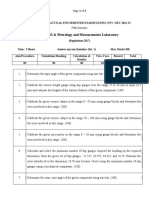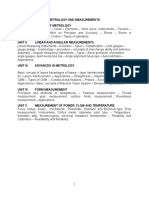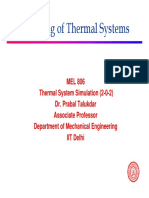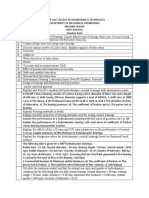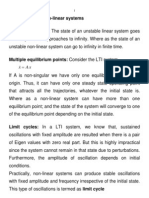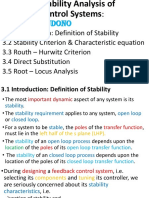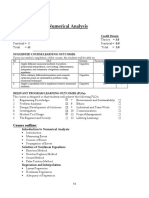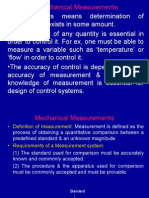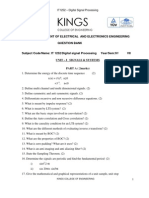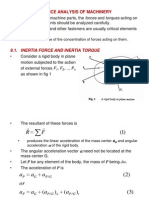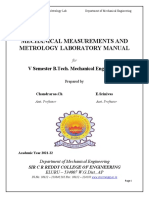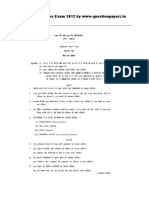Module-23 - Nyquist Stability Criterion: EE3101-Control Systems Engineering
Module-23 - Nyquist Stability Criterion: EE3101-Control Systems Engineering
Uploaded by
hariCopyright:
Available Formats
Module-23 - Nyquist Stability Criterion: EE3101-Control Systems Engineering
Module-23 - Nyquist Stability Criterion: EE3101-Control Systems Engineering
Uploaded by
hariOriginal Description:
Original Title
Copyright
Available Formats
Share this document
Did you find this document useful?
Is this content inappropriate?
Copyright:
Available Formats
Module-23 - Nyquist Stability Criterion: EE3101-Control Systems Engineering
Module-23 - Nyquist Stability Criterion: EE3101-Control Systems Engineering
Uploaded by
hariCopyright:
Available Formats
EE3101-Control Systems Engineering
Module-23_Nyquist Stability Criterion
Note: Refer the Video Lectures No-35 and 36 of Control Systems Engineering by Prof. M Gopal
The Nyquist criterion is a semi graphical method that determines the stability of a closed loop system by
investigating the properties of the frequency domain plot, the Nyquist Plot, of the loop transfer function
G(s)H(s) or L(s). Specifically, the Nyquist plot of L(s) is a plot of L() in the polar coordinates of
Im[L()] versus Re[L()] as varies from 0 . This is another example of using the properties of
the loop transfer function to find the performance of the closed loop system. The Nyquist criteria has the
following features.
1. In addition to providing the absolute stability, like the RH Criterion, the Nyquist criterion also gives
information on the relative stability of a stable system and the degree of instability of an unstable
system. It also gives an indication of how the system stability may be improved, if needed.
2. The Nyquist plot of G(s)H(s) or of L(s) is very easy to obtain, especially with the aid of a computer
3. The Nyquist Plot of G(s)H(s) gives information on the frequency domain characteristics such as
Resonant peak, resonant frequency, BW and others with ease.
4. The Nyquist Plot is useful for systems with pure time delay that cannot be treated with the RH
criterion and are difficult to analyze with the root locus method
Stability Problem:
The Nyquist Criterion represents the method of determining the location of the characteristic
equation roots with respect to the left half and the right half of the s-plane. Unlike the root locus
method, the Nyquist criterion does not give the exact location of the characteristic equation roots.
Let us consider the closed loop transfer function of a SISO system is
)
= )
1 + ))
Because the characteristic equation is obtained by setting the denominator polynomial of M(s) to
zero, the roots of the characteristic equation are also the zeros of 1+G(s)H(s). or the characteristic
equation must satisfy = )1 + ) = )0
In general, for a system with multiple number of loops, the denominator M(s) can be written as
= )1 + = )0
Where L(s) is the loop transfer function
Identification of Poles and Zeros:
Loop transfer function zeros: zeros of L(s)
Loop transfer function poles: poles of L(s)
Closed loop transfer function poles: zeros of 1+L(s) = roots of characteristic equation
Rajiv Gandhi University of Knowledge Technologies Page 1
S Hussain Vali, R K Valley
EE3101-Control Systems Engineering
Stability Conditions:
(a) Open loop Stability: A system is said to be open loop stable if the poles of the open loop transfer
function L(s) are all in left half s-plane.
(b) Closed loop stability: A system is said to be closed loop stable or simple stable if the poles of the
closed loop transfer function or the zeros of 1+L(s) are all in left half s-plane. Exceptions to the
above definitions are systems with poles or zeros intentionally placed at s=0
Encircled:
A point or region in a complex function plane is said to be encircled by a closed path if it is found
inside the path
For example point A in fig (a) is encircled by the closed path , because A is inside the closed path.
Point B is not encircled by the closed path , because it is outside the path. Further more when the
closed path has a direction assigned to it, the encirclement if made can be in clock wise (CW) or
the counter clock wise (CCW) direction. As shown in the fig (a) point A is encircled by in the
CCW direction. We can say that the region inside the path is encircled in the prescribed direction,
and the region outside the path is not encircled.
Enclosed:
A point or region is said to be enclosed by a closed path if it is encircled in the CCW direction or the
point or region lies to the left of the path when the path is traversed in the prescribed direction
The concept of enclosure is particularly useful if only a portion of the closed path is shown. For
example the shaded regions in the figs (b) and (c) are considered to be enclosed by the closed path .
In other words, point A in fig(b) is enclosed by , but point A in fig(c) is not. However point B and
all the points in the shaded region outside in fig(c) are enclosed
Rajiv Gandhi University of Knowledge Technologies Page 2
S Hussain Vali, R K Valley
EE3101-Control Systems Engineering
Number of Encirclements and Enclosures:
When a point is encircled by a closed path , a number N can be assigned to the number of times it
is encircled. The magnitude of N can be determined by drawing an arrow from the point to any
arbitrary point s1 on the closed path and then letting s1 follow the path in the prescribed direction
until it returns to the starting point. The total net number of revolutions traversed by this arrow is N,
or the net angle is 2 radians. For example point A in the fig (d) is encircled once or 2 radians by
, and point B is encircled twice or 4 radians, all CW direction. In fig (e) , point A is enclosed
once, and point B is enclosed twice by . By definition, N is positive for CCW encirclement and
negative for CW encirclement.
Principle of Argument:
Let )be a single valued function that has a finite number of poles in the s-plane. Suppose that an
arbitrary closed path is chosen in the s-plane so that the path does not go through any one of the
poles or zeros of ;)the corresponding locus mapped in the )plane will encircle the origin
as many times the difference between the number of zeros and poles of )that are encircled by the
s-plane locus
In equation form the principle of argument is stated as
Where
N=number of encirclement s of the origin made by the )plane locus
Z=number of zeros of )encircled by the s-plane locus in the s-plane
P=number of poles of )encircled by the s-plane locus in the s-plane
In general N can be positive, zero or negative. These are described as follows
Rajiv Gandhi University of Knowledge Technologies Page 3
S Hussain Vali, R K Valley
EE3101-Control Systems Engineering
1. N>0(Z>P). If the s-plane locus encircles more zeros than poles of )in a certain prescribed
direction (CW or CCW), N is a positive integer. In this case, )plane locus will encircle
the origin of the )plane N times in the same direction as that of
2. N=0(Z=P). If s-plane locus encircles as many poles as zeros, no poles and zeros of ), the
)plane locus will not encircle the origin of the )plane
3. N<0(Z<P). If s-plane locus encircles more poles than zeros of )in a certain direction, N is
negative integer. In this case the )plane locus will encircle the origin N times in the
opposite direction as that of
A convenient way of determining N with respect to the origin or any point of the )plane is
draw a line from the point in any direction to a point as far as necessary. The number of net
intersection of this line with the )locus gives the magnitude of N. figure below shows several
examples. In these cases it is assumed that the locus has a CCW sense.
A summary of all possible arguments are given in the table as follows
Rajiv Gandhi University of Knowledge Technologies Page 4
S Hussain Vali, R K Valley
EE3101-Control Systems Engineering
Critical Point:
For convenience, we shall designate the origin of the )plane as the critical point from which
the value of N is determined
Nyquist Path:
Principle of argument could be applied to solve the stability problem if the s-plane locus is taken
to be one that encircles the entire right half of the s-plane. Of course as an alternative can be
chosen to encircle the entire left half s-plane, as the solution is a relative one. Figure below
illustrates a locus with a CCW sense that encircles the entire right half of the s-plane.
Rajiv Gandhi University of Knowledge Technologies Page 5
S Hussain Vali, R K Valley
EE3101-Control Systems Engineering
This path is chosen to be the s-plane trajectory for the Nyquist criterion, since in mathematics;
CCW is traditionally defined to be positive sense. The path in the figure shown is defined to be
Nyquist path. Because Nyquist path must not pass through any poles and zeros of ), the small
semicircles shown along the axis in the figure are used to indicate that the path should go around
these poles and zeros if they fall on the axis. It is apparent that, if any pole and zero of )lies
inside the right half s-plane, it will be encircled by the Nyquist path .
Nyquist Criterion and the L(s) or the G(s)H(s) Plot:
The Nyquist criterion is a direct application of the principle of argument when the s-plane locus is
the Nyquist path of the figure above. In principle, once the Nyquist path is specified, the stability of
a closed loop system can be determined by plotting the = )1 + )locus when s taken on
values along the Nyquist path and investigating the behavior of the )plot with respect to the
critical point, which in this case is the origin of the )plane.
Because the function L(s) is generally known,
It would be simpler to construct the L(s) plot that corresponds to the Nyquist path, and the same
conclusion on the stability of the closed loop system can be obtained by observing the behavior of
the L(s) plot with respect to the (-1, j0) point in the L(s) plane.
This is because the origin of the = )1 + )plane corresponds to the (-1, j0) point in the L(s)
plane. Thus the (-1, j0) point in the L(s) plane becomes the critical point for the determination of the
closed loop stability.
For single loop systems, L(s)=G(s)H(s), the previous developments leads to the determination of the
closed loop stability by investigating the behavior of the G(s)H(s) plot with respect to the (-1, j0)
point of the G(s)H(s) plane. Thus, the Nyquist stability criterion is another example of using the loop
transfer function properties to find the behavior of closed loop systems.
Thus a given control system that has the characteristic equation given by equating the numerator
polynomial of 1+L(s) to zero, where L(s) is the loop transfer function, the application of the Nyquist
criterion to the stability problem involves the following steps
1. The Nyquist path is defined in the s-plane
2. The L(s) path corresponding to the Nyquist path is constructed in the L(s) plane
3. The value of N, the number of encirclements of the (-1, j0) point made by the L(s) plot is
observed
4. The Nyquist criterion follows from the equation N=Z-P
Where
N= Number of encirclements of the (-1, j0) point made by the L(s) plot
Z= Number of zeros of 1+L(s) that are inside the Nyquist path, that is, the right half s-plane
Rajiv Gandhi University of Knowledge Technologies Page 6
S Hussain Vali, R K Valley
EE3101-Control Systems Engineering
P= Number of poles of 1+L(s) that are inside the Nyquist path, that is, the right half s-plane.
Notice that the poles of 1+L(s) are the same as that of L(s)
The stability requirements for the two types of stability defined earlier are interpreted in terms of
Z and P
For closed loop stability Z must equal zero
For open loop stability P must equal zero
Thus the condition of stability according to the Nyquist criterion is stated as N=-P
That is,
For closed loop system to be stable, the L(s) plot must encircle the (-1, j0) point as many times as
the number of poles of L(s) that are in the right half s-plane, and the encirclement if any, must be
made in the clockwise direction (if is defined in the CCW sense)
Reference Books:
1. Chapter No: 8-5 of Automatic Control Systems by B C Kuo, 9th Edition
For any clarifications mail me at hussainvali4@gmail.com
Rajiv Gandhi University of Knowledge Technologies Page 7
S Hussain Vali, R K Valley
You might also like
- 2018 Book InitialAirworthinessDocument434 pages2018 Book InitialAirworthinessTAN WEI HAN0% (1)
- Lect 18Document18 pagesLect 18Gaurav AgarwalNo ratings yet
- Statics - Lecture 02 - Force VectorsDocument24 pagesStatics - Lecture 02 - Force VectorsyuyuNo ratings yet
- Week8 InterferometersDocument84 pagesWeek8 InterferometersArijit PanigrahyNo ratings yet
- CMM Inspection & Operating PrinciplesDocument15 pagesCMM Inspection & Operating PrinciplesMeena Ramesh100% (1)
- Classical & Advanced Optimization Techniques PDFDocument12 pagesClassical & Advanced Optimization Techniques PDFBarathNo ratings yet
- Automated Guided Vehicle System (AGVS)Document17 pagesAutomated Guided Vehicle System (AGVS)Anjan KumarNo ratings yet
- Disturbance Compensation For Gun Control System of Tank Based On LADRC (289KB)Document4 pagesDisturbance Compensation For Gun Control System of Tank Based On LADRC (289KB)Suresh SNo ratings yet
- Online and Offline MonitoringDocument4 pagesOnline and Offline MonitoringKuma DebelaNo ratings yet
- Beginner Tutorial For VisioDocument7 pagesBeginner Tutorial For VisioChintha KaluarachchiNo ratings yet
- MCQs of Introduction To Metrology, Linear and Angular Measurement (Mechanical MDocument4 pagesMCQs of Introduction To Metrology, Linear and Angular Measurement (Mechanical MAbhishek Yadav100% (1)
- ME8501 - Metrology and Measurements - Unit - IDocument30 pagesME8501 - Metrology and Measurements - Unit - Iarunpdc100% (1)
- ME8513 & Metrology and Measurements LaboratoryDocument3 pagesME8513 & Metrology and Measurements LaboratorySakthivel KarunakaranNo ratings yet
- Unit III Temporary and Permanent JointsDocument42 pagesUnit III Temporary and Permanent JointsJayashree rajamuruganNo ratings yet
- MEC 333 - Industry 4.O Syllabus-OEDocument3 pagesMEC 333 - Industry 4.O Syllabus-OEFiroz HussainNo ratings yet
- ME 6504 Metrology & Measurement All Unit NotesDocument91 pagesME 6504 Metrology & Measurement All Unit NotesKannan KamalNo ratings yet
- (13-14) - Modeling of Thermal SystemsDocument33 pages(13-14) - Modeling of Thermal SystemsmawooaNo ratings yet
- Numerical ControlDocument37 pagesNumerical ControlRammohan ReddyNo ratings yet
- Quantitative Methods 1Document15 pagesQuantitative Methods 1john goodpastureNo ratings yet
- Clustering AlgorithmDocument17 pagesClustering Algorithmspraga1995No ratings yet
- Engineering Graphics - Unit - 1 - Part 1Document41 pagesEngineering Graphics - Unit - 1 - Part 1SACHET GAJBHIYE100% (1)
- VHDL OperatorsDocument18 pagesVHDL OperatorsChaitanya Kapila100% (1)
- Question Bank Sliding Contact BearingsDocument2 pagesQuestion Bank Sliding Contact BearingsShree Prajapati100% (1)
- Programming in C Data Structures (15pcd13) - Notes PDFDocument108 pagesProgramming in C Data Structures (15pcd13) - Notes PDFChowkidar Abhijatha ShankarNo ratings yet
- Engineering Metrology & Measurements NotesDocument48 pagesEngineering Metrology & Measurements NotesJeevanandam Shanmuga100% (1)
- Speed Control of DC Motor Using Sliding Mode Control ApproachDocument6 pagesSpeed Control of DC Motor Using Sliding Mode Control ApproachIOSRjournalNo ratings yet
- Major Ilities of Avionics SystemDocument2 pagesMajor Ilities of Avionics SystemMoses RajasekaranNo ratings yet
- BCPE Sample Questions Answers July 2021Document13 pagesBCPE Sample Questions Answers July 2021daniyalc47100% (1)
- Exp No. 02 Study and Use of ComparatorsDocument8 pagesExp No. 02 Study and Use of Comparatorsrohit thorawadeNo ratings yet
- SeminarDocument29 pagesSeminarMohan UrsNo ratings yet
- Behaviour of Nonlinear SystemsDocument11 pagesBehaviour of Nonlinear SystemsCheenu SinghNo ratings yet
- Topic 3.0 Stability Analysis of FB Controlsystems TCE 5102Document30 pagesTopic 3.0 Stability Analysis of FB Controlsystems TCE 5102princekamutikanjoreNo ratings yet
- Unit 1 3transformationsDocument42 pagesUnit 1 3transformationsAkhilprasad SadigeNo ratings yet
- Unit Iii Visual RealismDocument59 pagesUnit Iii Visual RealismJabin JoeNo ratings yet
- Experiment # 01Document9 pagesExperiment # 01M.USMAN BIN AHMEDNo ratings yet
- Numerical Analysis Course Outline 2020Document2 pagesNumerical Analysis Course Outline 2020Muhammad Ahmad RazaNo ratings yet
- The Dynamic Model of The Slider-Crank MechanismDocument12 pagesThe Dynamic Model of The Slider-Crank MechanismPeet89No ratings yet
- Control Systems Notes SJBIT PDFDocument124 pagesControl Systems Notes SJBIT PDFSanath SanuNo ratings yet
- Algorithmic ComplexityDocument20 pagesAlgorithmic Complexitynguyenhau51496No ratings yet
- WattmeterDocument13 pagesWattmeterGovindaraju RajuNo ratings yet
- ComparatorsDocument23 pagesComparatorsShashwat RaiNo ratings yet
- Module 1.2Document36 pagesModule 1.2Mithun C MNo ratings yet
- Gradient Based OptimizationDocument24 pagesGradient Based OptimizationMarc RomaníNo ratings yet
- Meterology and Measurements: UNIT-2Document15 pagesMeterology and Measurements: UNIT-2EssKayNo ratings yet
- Measurements & TransducersDocument63 pagesMeasurements & TransducersManvendra Pratap Singh BishtNo ratings yet
- CappDocument14 pagesCappDerik Nelson100% (1)
- 2 Key Elements of MechatronicsDocument1 page2 Key Elements of Mechatronics9740177035100% (1)
- Metrology and Computer Aided InspectionDocument3 pagesMetrology and Computer Aided InspectionccritamNo ratings yet
- Fundamentals of Additive Manufacturing Technologies - Unit 4 - Week 2 - Computer Aided Process Planning For Additive ManufacturingDocument3 pagesFundamentals of Additive Manufacturing Technologies - Unit 4 - Week 2 - Computer Aided Process Planning For Additive ManufacturingSaurav KumarNo ratings yet
- RMT NotesDocument31 pagesRMT NotessherlinsamNo ratings yet
- Modern Control Systems (MCS) : Lecture-41-42 Design of Control Systems in Sate SpaceDocument21 pagesModern Control Systems (MCS) : Lecture-41-42 Design of Control Systems in Sate SpaceVeena Divya KrishnappaNo ratings yet
- Digital Signal Processing - Department of Electrical and Electronics EngineeringDocument12 pagesDigital Signal Processing - Department of Electrical and Electronics EngineeringBizura SarumaNo ratings yet
- Force Analysis of Machinery: 9.1. Inertia Force and Inertia TorqueDocument16 pagesForce Analysis of Machinery: 9.1. Inertia Force and Inertia TorqueaddisudagneNo ratings yet
- Motion Control Chapter 1 - IntroductionDocument43 pagesMotion Control Chapter 1 - IntroductionTrịnh Gia BảoNo ratings yet
- MM&M LAB STUDENT MANUAL Front PagesDocument6 pagesMM&M LAB STUDENT MANUAL Front Pageschandrarao chNo ratings yet
- Chapter 7Document31 pagesChapter 7mehmetgunn100% (1)
- MIMO Lecture Notes 1Document11 pagesMIMO Lecture Notes 1naveeth11No ratings yet
- 9.deep Feedforward NetworksDocument13 pages9.deep Feedforward NetworksKavitha100% (1)
- 2023handout 12 - System Stability Using Nyquist DiagramsDocument27 pages2023handout 12 - System Stability Using Nyquist DiagramsEnock PhiriNo ratings yet
- NyquistDocument25 pagesNyquistHosein KerdarNo ratings yet
- Frequency-Domain Analysis and Stability DeterminationDocument35 pagesFrequency-Domain Analysis and Stability DeterminationAliaa TarekNo ratings yet
- Exercise ProblemsDocument2 pagesExercise ProblemshariNo ratings yet
- Digital System Design: Course Educational ObjectivesDocument5 pagesDigital System Design: Course Educational ObjectiveshariNo ratings yet
- Module-17 - Routh-Hurwitz Criterion: EE3101-Control Systems EngineeringDocument8 pagesModule-17 - Routh-Hurwitz Criterion: EE3101-Control Systems EngineeringhariNo ratings yet
- CSLP 1.1 RMDocument7 pagesCSLP 1.1 RMhariNo ratings yet
- BOM Leadership Unit IIIDocument23 pagesBOM Leadership Unit IIIhariNo ratings yet
- Module2-Control System Basic Structure: EE3101-Control Systems EngineeringDocument6 pagesModule2-Control System Basic Structure: EE3101-Control Systems EngineeringhariNo ratings yet
- MIT6 02F12 Chap02Document12 pagesMIT6 02F12 Chap02gautruc408No ratings yet
- BOM Motivation (Unit III)Document20 pagesBOM Motivation (Unit III)hariNo ratings yet
- Verlogic3 Chapter7Document56 pagesVerlogic3 Chapter7hariNo ratings yet
- Module 14: Leadership Learning Objectives: George TerryDocument11 pagesModule 14: Leadership Learning Objectives: George TerryhariNo ratings yet
- Bom MboDocument10 pagesBom MbohariNo ratings yet
- StudentsAttendanceOctober 2017 07112017-F2Document173 pagesStudentsAttendanceOctober 2017 07112017-F2hariNo ratings yet
- BOM OrganizingDocument30 pagesBOM OrganizinghariNo ratings yet
- Summer Semester Remedial Time TableDocument1 pageSummer Semester Remedial Time TablehariNo ratings yet
- 329 PDFDocument1 page329 PDFhariNo ratings yet
- FTP PDFDocument1 pageFTP PDFhariNo ratings yet
- Rbigradebmainsexam2012 Paper III Finance and Management PDFDocument2 pagesRbigradebmainsexam2012 Paper III Finance and Management PDFhariNo ratings yet
- Iiit R.K.Valley, Rgukt Ap: IT Infra Related Problems Can Be Reported To Following MembersDocument1 pageIiit R.K.Valley, Rgukt Ap: IT Infra Related Problems Can Be Reported To Following MembershariNo ratings yet
- The Effects of Internet-Based Teaching and Learning Systems On LearnersDocument8 pagesThe Effects of Internet-Based Teaching and Learning Systems On LearnersRehab RadhiNo ratings yet
- ICST 2025 Brochure - 18 Oct 2024Document7 pagesICST 2025 Brochure - 18 Oct 2024pa924107No ratings yet
- Different Variables: Laiba Ijaz - Operational ResearchDocument26 pagesDifferent Variables: Laiba Ijaz - Operational ResearchLaiba MughalNo ratings yet
- Irandaam ThirumuraiDocument83 pagesIrandaam ThirumuraiMani MaranNo ratings yet
- Graph Partitioning Using Metaheuristic Techniques: Naresh Ghorpade, H. R. BhapkarDocument9 pagesGraph Partitioning Using Metaheuristic Techniques: Naresh Ghorpade, H. R. BhapkarNaresh GhorpadeNo ratings yet
- Failure Recovery in Distributed SystemsDocument24 pagesFailure Recovery in Distributed SystemsSudha PatelNo ratings yet
- Manage Product Keys Using VAMT 2.0Document5 pagesManage Product Keys Using VAMT 2.0Maestro Pisika LptNo ratings yet
- User GuidesDocument88 pagesUser GuidesThaj MohaideenNo ratings yet
- Service Manual: DSC-F828Document2 pagesService Manual: DSC-F828Anonymous Lfgk6vygNo ratings yet
- DebateDocument5 pagesDebatePauline pasajolNo ratings yet
- 51 - Interface With Staad Pro - DocDocument21 pages51 - Interface With Staad Pro - DocFauzankalibataNo ratings yet
- Operation and Maintenance ManualDocument22 pagesOperation and Maintenance ManualKiki HendraNo ratings yet
- Average Questions Specially For Sbi Po PrelimsDocument17 pagesAverage Questions Specially For Sbi Po PrelimssantoshkapalNo ratings yet
- Ece Vii Power Electronics 10ec73 NotesDocument264 pagesEce Vii Power Electronics 10ec73 NotesBhakti KalyankastureNo ratings yet
- Lec 2.0 Introduction To ColorDocument23 pagesLec 2.0 Introduction To ColorRojayneNo ratings yet
- ALPHACAM+2021 0+SU2114+Maintenance+ReportDocument9 pagesALPHACAM+2021 0+SU2114+Maintenance+ReportCnc TrafficNo ratings yet
- DocumentatieRoboti IRB360Document54 pagesDocumentatieRoboti IRB360Buta IonutNo ratings yet
- Holsapple Vita Sep 2019Document45 pagesHolsapple Vita Sep 2019CWHNo ratings yet
- h2 Generators - WM Series - Uk AsyntDocument2 pagesh2 Generators - WM Series - Uk Asyntapi-234089277No ratings yet
- Enterprise Security Competency Model: Gap Analysis WorksheetDocument22 pagesEnterprise Security Competency Model: Gap Analysis WorksheetadinaNo ratings yet
- A13 主板 PDFDocument36 pagesA13 主板 PDFRadi HerdiansahNo ratings yet
- Roy S Advanced Digital System DesignDocument466 pagesRoy S Advanced Digital System DesignYoussef ThelordNo ratings yet
- Photogate PDFDocument3 pagesPhotogate PDFBebeh Wahid Nuryadin0% (1)
- A Project Report of Flipkart and Amazon Bba 6 Sem Gunjan Correct FileDocument80 pagesA Project Report of Flipkart and Amazon Bba 6 Sem Gunjan Correct FileSalviaNo ratings yet
- Wearable Gadgets InnovationDocument14 pagesWearable Gadgets InnovationKaranNo ratings yet
- HF/VHF/UHF RF Power N-Channel MOSFET: FeaturesDocument13 pagesHF/VHF/UHF RF Power N-Channel MOSFET: FeaturesRoberto AlejandroNo ratings yet
- Math 21 Lec 2.6 Concavity and SDT (Slides)Document26 pagesMath 21 Lec 2.6 Concavity and SDT (Slides)Zyrille SilvaNo ratings yet
- Cash DrawerDocument17 pagesCash DrawerMilenko NanjariNo ratings yet
- Adafruit Neopixel UberguideDocument97 pagesAdafruit Neopixel UberguideJohn WestNo ratings yet












